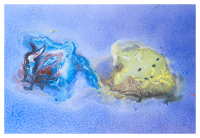Speaker
Tatiana Drozhzhova
(Saint-PetersburgState University)
Description
We present the critical review of estimates of centrality in AA and pA collisions that are usually done by selection of classes of events with certain charged particles multiplicity. Results of MC simulations in different models are presented. They include the Standard Glauber, the Modified Glauber model [1] and HIJING[2] event generator (with gluon shadowing) MC calculations. We present the estimates of the number of participants (Npart) and of the nucleon-nucleon collisions (Ncoll) and their distributions and relations to the impact parameter in AA, and pA interactions at the LHC energy. It is obtained that the distributions in Npart, relevant to the narrow (1%) multiplicity class selection in Pb-Pb collisions, are wider than could be expected. Results of models [1-2] are found to be in agreement with and AMPT[3] and the non-Glauber Model MC calculations [4], all these data are pointing at the considerable stopping of nucleons (or high role of gluon shadowing) in Pb-Pb and p-Pb interactions at the LHC energies. It is shown that, contrary to the Standard Glauber model, the account of the energy-momentum conservation in soft particles production, that is intrinsically present in the models [1-4], leads to the noticeable decrease in the mean number of nucleon collisions Ncoll in Pb-Pb and p-Pb interactions at the LHC energies. Importance of these effects in search of the critical phenomena at the SPS energies is also discussed.
The authors acknowledge Saint-Petersburg State University for a research
grant 11.38.66.2012
References:
[1] G. Feofilov, A. Ivanov, Number of nucleon-nucleon collisions vs energy in modified Glauber calculations // Journal of Physics G CS, 5, (2005) 230-237
[2] HIJING, R. Xu, W.-T. Deng, and X.-N. Wang, arXiv:1204.1998
[3] AMPTJ. Albaete, N. Armesto, R. Baier, et al., Int. J. Mod. Phys. E 22, 1330007 (2013), arXiv:1301.3395 [hep-ph].
[4] V. Kovalenko, Phys. Atom. Nucl. 76, 1189 (2013), arXiv:1211.6209 [hep-ph]; arXiv:1308.1932 [hep-ph], 2013; V. Kovalenko, V. Vechernin. PoS(BaldinISHEPP XXI) 077, 2012, arXiv:1212.2590 [nucl-th]
Author
Tatiana Drozhzhova
(Saint-PetersburgState University)
Co-authors
Andrey Seryakov
(St. Petersburg State University (RU))
Grigori Feofilov
(St. Petersburg State University (RU))
Vladimir Kovalenko
(St. Petersburg State University (RU))
